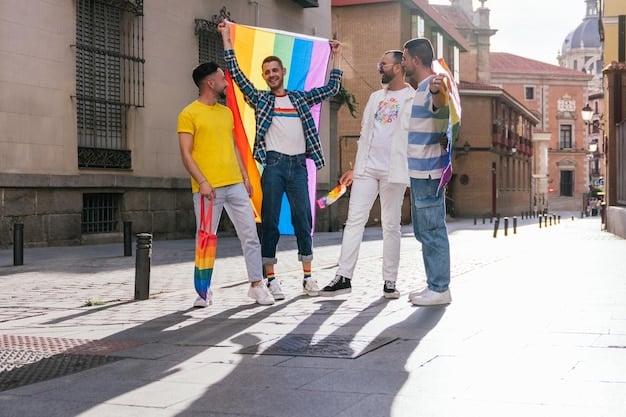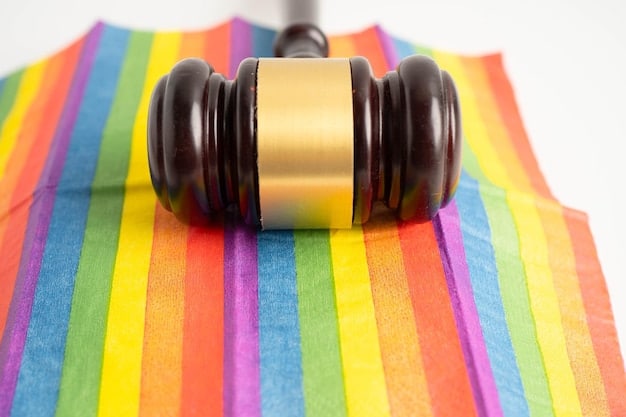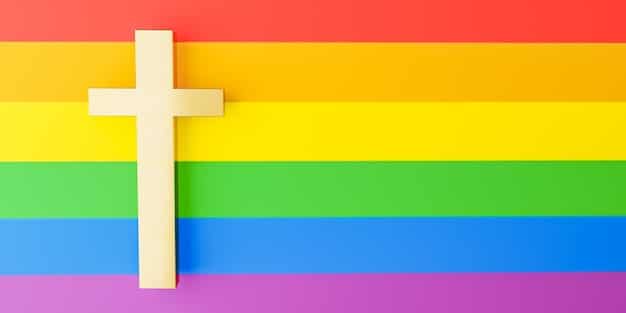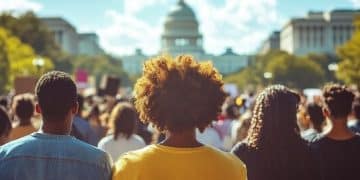LGBTQ+ Rights in the US: A 2025 Update

Understanding the current landscape of LGBTQ+ rights in the US: A 2025 update reveals a complex interplay of legal advancements, persistent discrimination, and evolving societal attitudes impacting LGBTQ+ individuals and communities across the nation.
As we move into 2025, understanding the current landscape of LGBTQ+ rights in the US: A 2025 update requires a nuanced perspective, acknowledging both progress and ongoing challenges.
Navigating the Evolving Legal Framework
The legal framework surrounding LGBTQ+ rights in the US is in constant flux, marked by landmark Supreme Court decisions and varying state laws. Understanding these legal dynamics is crucial for assessing the overall landscape of LGBTQ+ rights.
Federal Protections and Limitations
While the Supreme Court’s decision in Bostock v. Clayton County extended Title VII protections to LGBTQ+ employees, federal law still lacks comprehensive non-discrimination protections in areas like housing and public accommodations.
State-Level Variations and Challenges
Many states have enacted their own non-discrimination laws, but significant disparities exist, leading to a patchwork of protections across the country. Some states have also introduced or passed legislation that could undermine LGBTQ+ rights.
- Examining the implications of state-level religious freedom restoration acts (RFRAs) on LGBTQ+ rights.
- Analyzing the impact of state laws that specifically target transgender individuals, particularly in areas like healthcare and sports.
- Understanding the legal challenges to these laws and their potential outcomes.
In conclusion, the legal landscape for LGBTQ+ rights in the US is marked by both progress and persistent inequalities. Federal protections remain limited, while state-level variations create a complex and often challenging environment for LGBTQ+ individuals.

The Shifting Political Climate and Its Impact
The political climate plays a significant role in shaping LGBTQ+ rights in the US. Changes in administration, legislative priorities, and judicial appointments can have profound effects on the legal and social landscape for LGBTQ+ individuals.
The Role of Political Parties
The two major political parties hold vastly different views on LGBTQ+ rights, with the Democratic Party generally supporting expanded protections and the Republican Party often opposing such measures or advocating for religious exemptions.
Legislative and Executive Actions
Federal and state legislatures can introduce and pass laws that either advance or undermine LGBTQ+ rights. Executive actions, such as executive orders and agency guidance, can also have a significant impact.
- Analyzing the potential impact of the 2024 elections on LGBTQ+ rights at the federal and state levels.
- Examining the role of advocacy groups and grassroots movements in influencing policy decisions.
- Understanding the influence of public opinion and cultural shifts on the political climate.
To summarize, the political climate is a critical factor in shaping LGBTQ+ rights in the US. The stances of political parties, legislative and executive actions, and the influence of advocacy groups all contribute to the ongoing struggle for equality and inclusion.
Transgender Rights: A Focal Point of Debate
Transgender rights have become a central focus of debate in recent years, with significant legal and social implications for transgender individuals and the broader LGBTQ+ community. Understanding the key issues and perspectives is essential for a comprehensive understanding of the overall landscape.
Access to Healthcare
Access to gender-affirming healthcare is a critical issue for transgender individuals, with many facing significant barriers, including discrimination, lack of insurance coverage, and restrictive state laws.
Bathroom Access and Gender Identity in Schools
Laws regarding bathroom access and gender identity in schools have become highly contentious, with many states introducing or passing legislation that restricts or bans transgender students from using bathrooms and participating in sports consistent with their gender identity.
- Examining the legal challenges to these laws and their potential impact on transgender students.
- Analyzing the arguments for and against these laws from different perspectives.
- Understanding the experiences of transgender students and educators in navigating these policies.
In short, transgender rights have emerged as a central battleground in the fight for LGBTQ+ equality. Access to healthcare, bathroom access, and gender identity in schools are key areas of debate, with significant legal, social, and personal implications for transgender individuals.
The Intersection of LGBTQ+ Rights and Religious Freedom
The intersection of LGBTQ+ rights and religious freedom has become increasingly contentious, with many religious individuals and organizations seeking exemptions from non-discrimination laws based on their religious beliefs. Balancing these competing interests is a complex and ongoing challenge.
Religious Freedom Restoration Acts (RFRAs)
Religious Freedom Restoration Acts (RFRAs) at the federal and state levels have been used to justify discrimination against LGBTQ+ individuals, with some arguing that these laws protect their right to refuse service or employment based on religious objections.
The Scope of Religious Exemptions
The scope of religious exemptions in non-discrimination laws is a key area of debate, with some arguing that exemptions should be narrowly tailored to protect core religious beliefs, while others advocate for broader exemptions.
- Analyzing the legal and ethical implications of religious exemptions in non-discrimination laws.
- Examining the impact of these exemptions on LGBTQ+ individuals and communities.
- Understanding the different perspectives on how to balance religious freedom and LGBTQ+ equality.
In conclusion, the intersection of LGBTQ+ rights and religious freedom presents a complex challenge. Balancing the constitutional right to religious freedom with the need to protect LGBTQ+ individuals from discrimination requires careful consideration and nuanced solutions.

Addressing Discrimination and Promoting Inclusion
Despite legal advancements, LGBTQ+ individuals continue to face significant discrimination in various areas of life, including employment, housing, healthcare, and education. Addressing this discrimination and promoting inclusion are essential for creating a more equitable society.
Discrimination in Employment and Housing
Many LGBTQ+ individuals face discrimination in employment and housing, with some being denied jobs or housing based on their sexual orientation or gender identity. While some states have enacted non-discrimination laws, federal protections are still lacking in these areas.
Bullying and Harassment in Schools
Bullying and harassment in schools remain a significant problem for LGBTQ+ students, with many experiencing verbal, physical, and online abuse. Creating safe and inclusive school environments is crucial for protecting the well-being of LGBTQ+ youth.
- Analyzing the impact of anti-bullying policies and inclusive curricula on LGBTQ+ students.
- Examining the role of educators and administrators in creating a supportive school climate.
- Understanding the resources and support available to LGBTQ+ students and their families.
In summary, addressing discrimination and promoting inclusion are crucial steps towards creating a more just and equitable society for LGBTQ+ individuals. Strengthening non-discrimination laws, combating bullying and harassment, and promoting inclusive policies are all essential for ensuring that LGBTQ+ individuals can live with dignity and respect.
Social Attitudes and Cultural Shifts
Social attitudes towards LGBTQ+ individuals have shifted dramatically in recent decades, with increasing acceptance and support for LGBTQ+ rights. However, prejudice and discrimination still persist, highlighting the need for continued education and awareness efforts.
Changing Public Opinion
Public opinion polls consistently show increasing support for LGBTQ+ rights, with a majority of Americans now supporting same-sex marriage and non-discrimination protections. However, divisions remain, particularly along partisan and religious lines.
The Role of Media and Representation
The mainstream media has played a significant role in shaping public perceptions of LGBTQ+ individuals, with increasing representation of LGBTQ+ characters and storylines in film, television, and other media. Positive and accurate representation can help to normalize LGBTQ+ identities and reduce prejudice.
- Analyzing the impact of LGBTQ+ representation in the media on social attitudes and public opinion.
- Examining the role of LGBTQ+ artists and activists in promoting visibility and acceptance.
- Understanding the challenges and opportunities for continued progress in shaping social attitudes.
In conclusion, social attitudes towards LGBTQ+ individuals have undergone a significant transformation, with increasing acceptance and support. However, continued efforts are needed to combat prejudice, promote understanding, and create a more inclusive and welcoming society for all.
| Key Area | Brief Description |
|---|---|
| ⚖️ Legal Framework | Inconsistent protections: federal gaps, state variations. |
| 🗳️ Political Climate | Partisan divides shape policy outcomes significantly. |
| 🏳️⚧️ Transgender Rights | Healthcare & school policies are key battlegrounds. |
| 🤝 Inclusion Efforts | Combating discrimination remains critical. |
Frequently Asked Questions
▼
Currently, no comprehensive federal law explicitly protects LGBTQ+ individuals from discrimination in all areas of life. The Supreme Court’s Bostock v. Clayton County decision extended Title VII protections to LGBTQ+ employees.
▼
State laws vary widely, with some states having comprehensive non-discrimination laws and others having limited or no protections. This creates a patchwork of rights across the country.
▼
RFRAs are laws that protect religious freedom, allowing individuals and organizations to seek exemptions from laws that they believe infringe upon their religious beliefs. They can impact LGBTQ+ rights.
▼
Transgender individuals face numerous challenges, including discrimination in healthcare and employment, restrictions on bathroom access, and bullying in schools; these are the main hurdles.
▼
Public support for LGBTQ+ rights has increased significantly in recent decades, with a majority of Americans now supporting same-sex marriage and non-discrimination protections; this reflects cultural progress.
Conclusion
In conclusion, understanding the current landscape of LGBTQ+ rights in the US: A 2025 update reveals a complex and evolving situation. While progress has been made in some areas, significant challenges remain, highlighting the need for continued advocacy and vigilance in the pursuit of equality and justice for all LGBTQ+ individuals.





